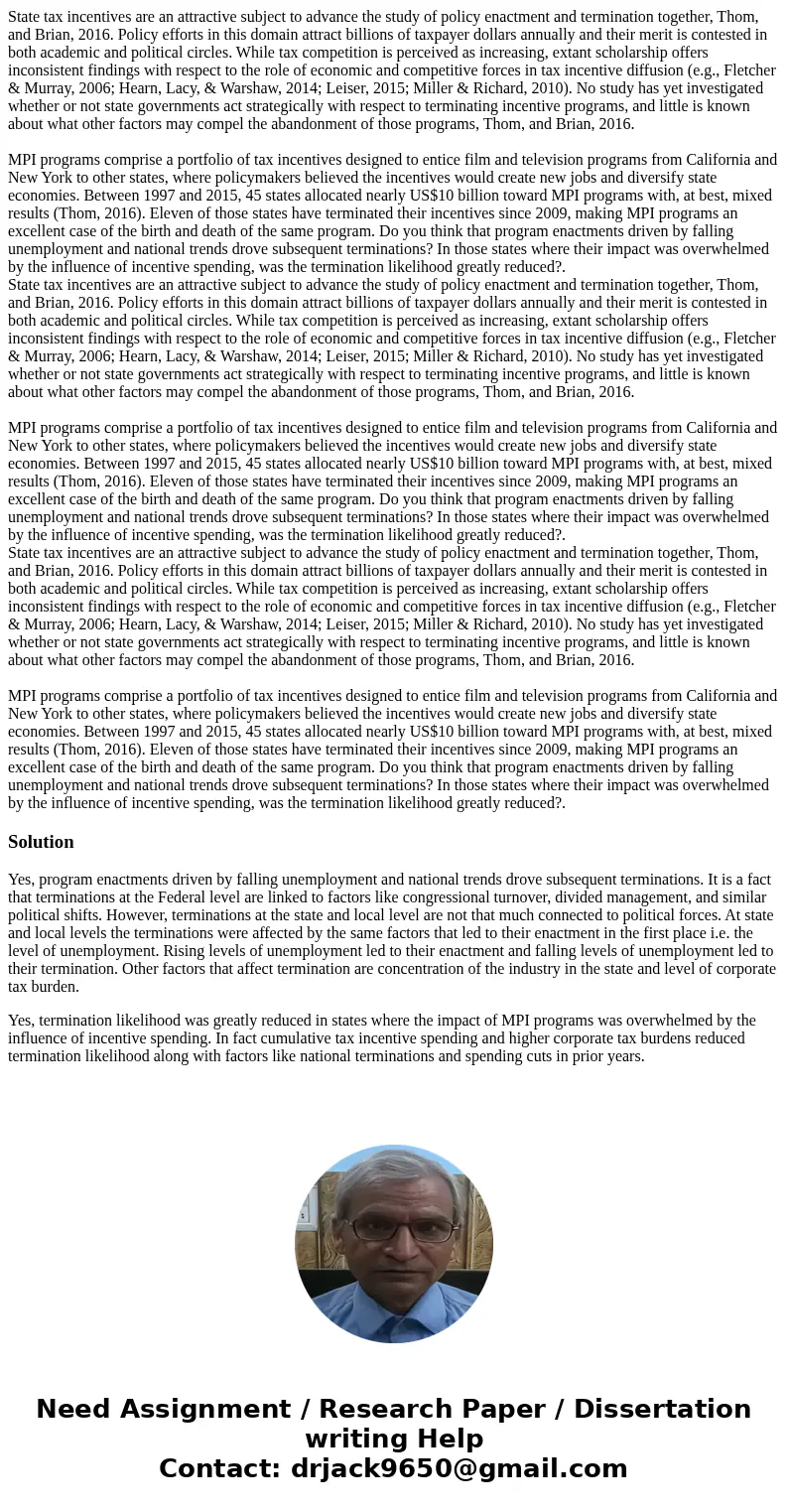State tax incentives are an attractive subject to advance the study of policy enactment and termination together, Thom, and Brian, 2016. Policy efforts in this domain attract billions of taxpayer dollars annually and their merit is contested in both academic and political circles. While tax competition is perceived as increasing, extant scholarship offers inconsistent findings with respect to the role of economic and competitive forces in tax incentive diffusion (e.g., Fletcher & Murray, 2006; Hearn, Lacy, & Warshaw, 2014; Leiser, 2015; Miller & Richard, 2010). No study has yet investigated whether or not state governments act strategically with respect to terminating incentive programs, and little is known about what other factors may compel the abandonment of those programs, Thom, and Brian, 2016.
MPI programs comprise a portfolio of tax incentives designed to entice film and television programs from California and New York to other states, where policymakers believed the incentives would create new jobs and diversify state economies. Between 1997 and 2015, 45 states allocated nearly US$10 billion toward MPI programs with, at best, mixed results (Thom, 2016). Eleven of those states have terminated their incentives since 2009, making MPI programs an excellent case of the birth and death of the same program. Do you think that program enactments driven by falling unemployment and national trends drove subsequent terminations? In those states where their impact was overwhelmed by the influence of incentive spending, was the termination likelihood greatly reduced?.
State tax incentives are an attractive subject to advance the study of policy enactment and termination together, Thom, and Brian, 2016. Policy efforts in this domain attract billions of taxpayer dollars annually and their merit is contested in both academic and political circles. While tax competition is perceived as increasing, extant scholarship offers inconsistent findings with respect to the role of economic and competitive forces in tax incentive diffusion (e.g., Fletcher & Murray, 2006; Hearn, Lacy, & Warshaw, 2014; Leiser, 2015; Miller & Richard, 2010). No study has yet investigated whether or not state governments act strategically with respect to terminating incentive programs, and little is known about what other factors may compel the abandonment of those programs, Thom, and Brian, 2016.
MPI programs comprise a portfolio of tax incentives designed to entice film and television programs from California and New York to other states, where policymakers believed the incentives would create new jobs and diversify state economies. Between 1997 and 2015, 45 states allocated nearly US$10 billion toward MPI programs with, at best, mixed results (Thom, 2016). Eleven of those states have terminated their incentives since 2009, making MPI programs an excellent case of the birth and death of the same program. Do you think that program enactments driven by falling unemployment and national trends drove subsequent terminations? In those states where their impact was overwhelmed by the influence of incentive spending, was the termination likelihood greatly reduced?.
State tax incentives are an attractive subject to advance the study of policy enactment and termination together, Thom, and Brian, 2016. Policy efforts in this domain attract billions of taxpayer dollars annually and their merit is contested in both academic and political circles. While tax competition is perceived as increasing, extant scholarship offers inconsistent findings with respect to the role of economic and competitive forces in tax incentive diffusion (e.g., Fletcher & Murray, 2006; Hearn, Lacy, & Warshaw, 2014; Leiser, 2015; Miller & Richard, 2010). No study has yet investigated whether or not state governments act strategically with respect to terminating incentive programs, and little is known about what other factors may compel the abandonment of those programs, Thom, and Brian, 2016.
MPI programs comprise a portfolio of tax incentives designed to entice film and television programs from California and New York to other states, where policymakers believed the incentives would create new jobs and diversify state economies. Between 1997 and 2015, 45 states allocated nearly US$10 billion toward MPI programs with, at best, mixed results (Thom, 2016). Eleven of those states have terminated their incentives since 2009, making MPI programs an excellent case of the birth and death of the same program. Do you think that program enactments driven by falling unemployment and national trends drove subsequent terminations? In those states where their impact was overwhelmed by the influence of incentive spending, was the termination likelihood greatly reduced?.
Yes, program enactments driven by falling unemployment and national trends drove subsequent terminations. It is a fact that terminations at the Federal level are linked to factors like congressional turnover, divided management, and similar political shifts. However, terminations at the state and local level are not that much connected to political forces. At state and local levels the terminations were affected by the same factors that led to their enactment in the first place i.e. the level of unemployment. Rising levels of unemployment led to their enactment and falling levels of unemployment led to their termination. Other factors that affect termination are concentration of the industry in the state and level of corporate tax burden.
Yes, termination likelihood was greatly reduced in states where the impact of MPI programs was overwhelmed by the influence of incentive spending. In fact cumulative tax incentive spending and higher corporate tax burdens reduced termination likelihood along with factors like national terminations and spending cuts in prior years.

 Homework Sourse
Homework Sourse